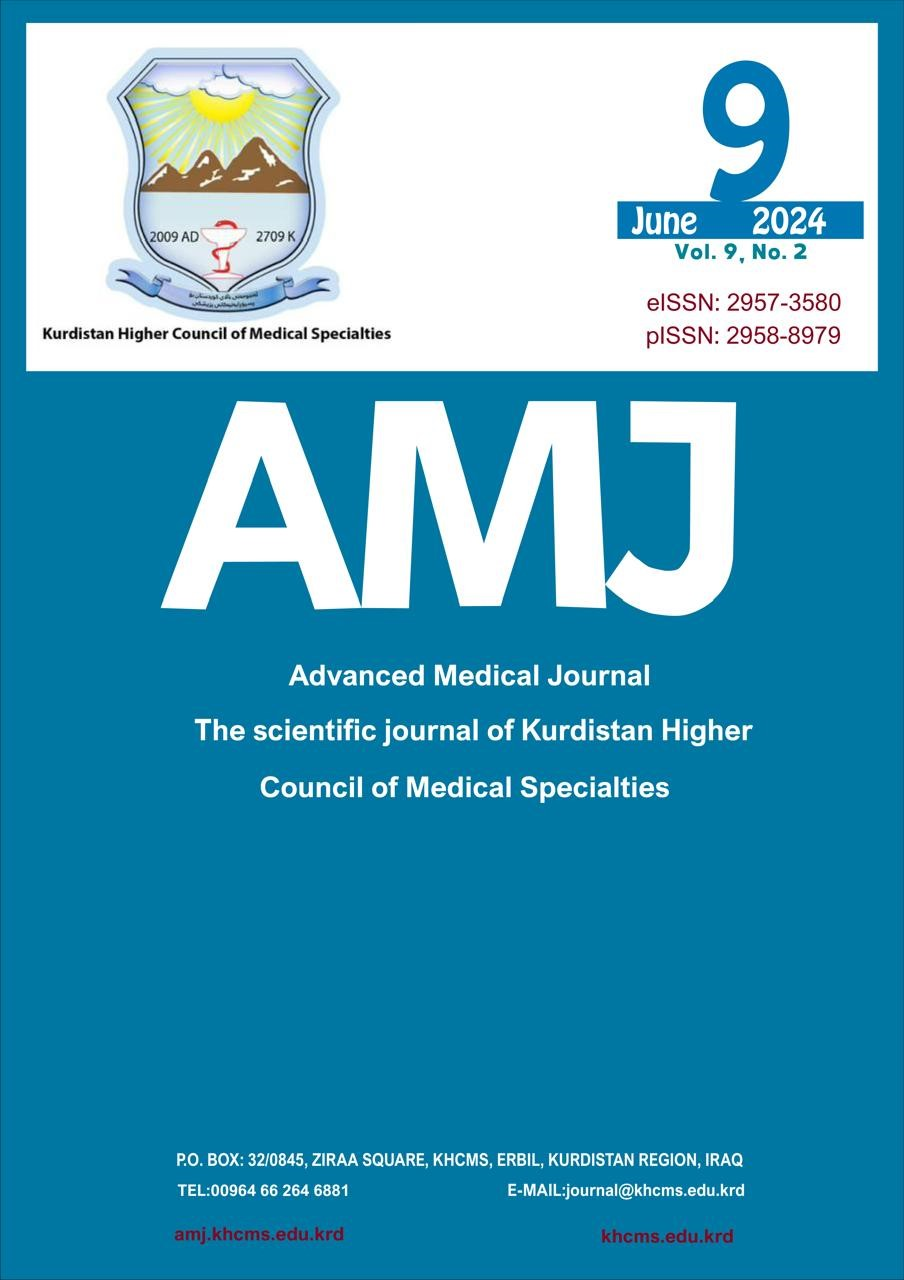Clinical and Dermoscopic evaluation of post acne erythema after treatment with topical timolol maleate 0.5%
DOI:
https://doi.org/10.56056/amj.2024.258Keywords:
Acne, Dermoscopy, Post-acne erythema, Timolol maleateAbstract
Background and objectives: A common consequence of acne inflammation is called post-acne erythema, which describes telangiectasia and erythematous lesions that persist even after acne treatment, although some post-acne erythema lesions may become better with time. For some patients, having prolonged post-acne erythema might not be acceptable. Many studies have assessed the effectiveness of various post-acne erythema therapeutic approaches; however, there is no standard treatment. The aim of this study was to evaluate efficacy and safety of topical timolol maleate 0.5% in the treatment of post-acne erythema clinically and by dermoscopy.
Methods: A randomized therapeutic clinical trial conducted in Sulaimanyah city-Kurdistan region over a period from March to September of 2022.Thirty patients (24 female and 6 male) with persistent post-acne erythema were enrolled in this study. Treatments with timolol 0.5% ophthalmic solution: apply 3-5 drops of timolol over the affected area every night at bedtime for 12 weeks. Our objectives were patient satisfaction, dermoscopy-assessed erythema assessment, and physician-reported clinical improvement.
Result: After 12 weeks of treatment, there were no patients with severe erythema, clinically and statistically; there was a marked decline in the mean clinician erythema score and its standard deviation from 2.7± 0.98 to 1.0 ± 1.0 Also by dermoscopy-assessed erythema assessment, there was a substantial decrease in the mean erythema score and its standard deviation from 2.0±0.72 to 0.70±0.70, no participants after therapy exhibited severe erythema by dermoscopy.so statistically there is significant reduction in erythema clinically and dermoscopically.
Conclusion: The results of this study show that there was very good response of post-acne erythema lesions with no obvious side effects, further therapeutic clinical studies with larger sample size is needed.
Downloads
References
Tuchayi S, Makrantonaki E, Ganceviciene R, Dessinioti C, Feldman SR, Zouboulis CC. Acne vulgaris. Nat Rev Dis Primers 2015; 1: 15029.
Bhate K. Williams H.C. Epidemiology of acne vulgaris. Br J Dermatol. 2013; 168: 474-85
Bellew S, Thiboutot D, Del Rosso JQ. Pathogenesis of acne vulgaris: what’s new, what’s interesting and what may be clinically relevant. J Drugs Dermatol. 2011;10(6):582–5.
Suh DH, Kwon HH. What’s new in the physiopathology of acne? Br J Dermatol. 2015;172:13–19. 1
Tanghetti EA. The role of inflammation in the pathology of acne. J Clin Aesthet Dermatol 2013;6(9):27–35.
Bae-HarboeYS, GraberEM. Easy as PIE (Postinflammatory Erythema). J Clin Aesthet Dermatol 2013;6(9):46–7.
Panchaprateep R, Munavalli G. Low-fluence 585 nm Q-switched Nd:YAG laser: a novel laser treatment for post-acne erythema. Lasers Surg Med 2015; 47:148-55.
Abdelrazik, Combination of skin micro-needling and topical application of tranexamic acid and vitamin C: New clinical application: A pilot study for treatment of persistent post acne erythema. J Am Acad Dermatol. 2016;74(5): AB4
Glaich AS, Goldberg LH, Friedman RH, Friedman PM. Fractional photothermolysis for the treatment of postinflammatory erythema resulting from acne vulgaris. Dermatol Surg. 2007;33(7):842–6
Yoon HJ, Lee DH, Kim SO, Park KC, Youn SW. Acne erythema improvement by long-pulsed 595-nm pulsed-dye laser treatment: a pilot study. J Dermatolog Treat 2008;19-(1):38–44.
Park KY, Ko EJ, Seo SJ, Hong CK. Comparison of fractional, nonablative, 1550-nm laser and 595-nm pulsed dye laser for the treatment of facial erythema resulting from acne: a split-face, evaluator-blinded, randomized pilot study. J Cosmet Laser Ther. 2014;16(3):120–3
Wang B, Wu Y, Luo YJ, et al. Combination of intense pulsed light and fractional CO(2) laser treatments for patients with acne with inflammatory and scarring lesions. Clin Exp Dermatol 2013;38: 344-51.
Afra TP, Razmi T M, De D. Topical timolol for postacne erythema. J Am Acad Dermatol. 2021;84(6):255–6
Krakowski AC, Nguyen TA. Inhibition of angiofibromas in a tuberous sclerosis patient using topical timolol 0.5% gel. Pediatrics. 2015; 136(3):709–13.
Khan M, Boyce A, Prieto-Merino D, et al. The Role of Topical Timolol in the Treatment of Infantile Hemangiomas: A Systematic Review and Meta-analysis. Acta Derm Venereol. 2017, 97 (10). 1167-71.
Raghallaigh SN, Powell FC. Rosacea. In: European Handbook of Dermatological Treatments. Berlin, Germany: Springer; 2015: 835-43
Arora P, Meena N, Sharma PK, Bhardwaj M. Angiolymphoid hyperplasia with eosinophilia and its response to the combination of radiofrequency ablation and topical timolol. Indian Dermatol Online J. 2017;8(4):267–70.
Errichetti E, Stinco G. Dermoscopy in general dermatology: a practical overview. Dermatol Ther (Heidelb) 2016;6(4):471–507
Errichetti E, Stinco G. The practical usefulness of dermoscopy in general dermatology. G Ital Dermatol Venereol. 2015;150(5):533–46.
Tan J, Liu H, Leyden J, Leoni M. Reliability of Clinician Erythema Assessment grading scale. J Am Acad Dermatol. 2014; 71:760–3
Frommelt P. Juern A.Siegel D.et al. Adverse events in young and preterm infants receiving topical timolol for infantile hemangioma. Pediatr Dermatol. 2016; 33: 405-14
Abdel Hay R, Hegazy R, Abdel Hady M, Saleh N. Clinical and dermoscopic evaluation of combined (salicylic acid 20% and azelaic acid 20%) versus trichloroacetic acid 25% chemical peel in acne: an RCT. J Dermatolog Treat . 2019;30(6):572–7
Harper JC. An update on the pathogenesis and management of acne vulgaris. J Am Acad Dermatol. 2004;51(1 Suppl):36–8.
Agamia N, Essawy M, Kassem A. Successful treatment of the face post acne erythema using a topically applied selective alpha 1-Adrenergic receptor agonist, oxymetazoline 1.5%, a controlled left to right face comparative trial. J Dermatolog Treat. 2022;33(2):904–9
Jakhar D, Kaur I. Topical 5% tranexamic acid for acne-related postinflammatory erythema. J Am Acad Dermatol. 2020;82(6):e187–8
Glaich AS, Friedman PM, Jih MH, Goldberg LH. Treatment of inflammatory facial acne vulgaris with combination 595-nm pulsed-dye laser with dynamic-cooling-device and 1,450-nm diode laser. Lasers Surg Med 2006;38(3):177–80.
Erceg A, de Jong EM, van de Kerkhof PC, Seyger MM. The efficacy of pulsed dye laser treatment for inflammatory skin diseases: A systematic review. J Am Acad Dermatol 2013; 69(4):609–15.
Karsai S, Schmitt L, Raulin C. The pulsed-dye laser as an adjuvant treatment modality in acne vulgaris: A randomized controlled single-blinded trial. Br J Dermatol 2010; 163(2):395–401.
Leheta TM. Role of the 585-nm pulsed dye laser in the treatment of acne in comparison with other topical therapeutic modalities. J Cosmet Laser Ther 2009;11(2): 118–24.
.Jung JY, Choi YS, Yoon MY, Min SU, Suh DH. Comparison of a pulsed dye laser and a combined 585/1,064-nm laser in the treatment of acne vulgaris. Dermatol Surg 2009;35(8):1181–7.
Haedersdal M, Togsverd-Bo K, Wiegell SR, Wulf HC. Long-pulsed dye laser versus long-pulsed dye laserassisted photodynamic therapy for acne vulgaris: A randomized controlled trial. J Am Acad Dermatol 2008;58- (3):387–94.
Seaton ED, Charakida A, Mouser PE, Grace I, Clement RM, Chu AC. Pulsed-dye laser treatment for inflammatory acne vulgaris: randomised controlled trial. Lancet 2003;362- (9393):1347–52.
Downloads
Published
How to Cite
Issue
Section
License
Copyright (c) 2024 Sawen Jihanger Omer, Mohammed Yousif Saeed Jaf , Shawkat Abubakr Hassan

This work is licensed under a Creative Commons Attribution-NonCommercial-ShareAlike 4.0 International License.
The copyright on any article published in AMJ (The Scientific Journal of Kurdistan Higher Council of Medical Specialties )is retained by the author(s) in agreement with the Creative Commons Attribution Non-Commercial ShareAlike License (CC BY-NC-SA 4.0)









